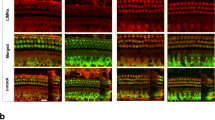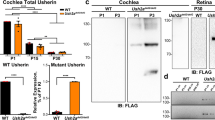Abstract
Deafness is the prevailing sensory impairment among humans, impacting every aspect of one's existence. Half of congenital deafness cases are attributed to genetic factors. Studies have shown that Luzp2 is expressed in hair cells (HCs) and supporting cells of the inner ear, but its specific role in hearing remains unclear. To determine the importance of Luzp2 in auditory function, we generated mice deficient in Luzp2. Our results revealed that Luzp2 has predominant expression within the HCs and pillar cells. However, the loss of Luzp2 did not result in any changes in auditory threshold. HCs or synapse number and HC stereocilia morphology in Luzp2 knockout mice did not show any notable distinctions. This was the first study of the role of Luzp2 in hearing in mice, and our results provide important guidance for the screening of deafness genes.






Similar content being viewed by others
Data Availability Statement
The data sets used and analyzed during the present study are available from the corresponding author upon reasonable request.
References
WHO. Deafness and hearing loss. Homepage Available from: https://www.who.int/health-topics/hearing-loss#tab=tab_2.
Géléoc GS, Holt JR. Sound strategies for hearing restoration. Science 2014, 344: 1241062.
Ahmed H, Shubina-Oleinik O, Holt JR. Emerging gene therapies for genetic hearing loss. J Assoc Res Otolaryngol 2017, 18: 649–670.
Defourny J, Lallemend F, Malgrange B. Structure and development of cochlear afferent innervation in mammals. Am J Physiol Cell Physiol 2011, 301: C750–C761.
Fettiplace R. Hair cell transduction, tuning, and synaptic transmission in the mammalian cochlea. Compr Physiol 2017, 7: 1197–1227.
Schwander M, Kachar B, Müller U. Review series: The cell biology of hearing. J Cell Biol 2010, 190: 9–20.
Raphael Y, Altschuler RA. Structure and innervation of the cochlea. Brain Res Bull 2003, 60: 397–422.
Chen Y, Lu X, Guo L, Ni W, Zhang Y, Zhao L. Hedgehog signaling promotes the proliferation and subsequent hair cell formation of progenitor cells in the neonatal mouse cochlea. Front Mol Neurosci 2017, 10: 426.
Cheng C, Guo L, Lu L, Xu X, Zhang S, Gao J, et al. Characterization of the transcriptomes of Lgr5+ hair cell progenitors and Lgr5- supporting cells in the mouse cochlea. Front Mol Neurosci 2017, 10: 122.
Wu J, Li W, Lin C, Chen Y, Cheng C, Sun S, et al. Co-regulation of the Notch and Wnt signaling pathways promotes supporting cell proliferation and hair cell regeneration in mouse utricles. Sci Rep 2016, 6: 29418.
Cox BC, Chai R, Lenoir A, Liu Z, Zhang L, Nguyen DH, et al. Spontaneous hair cell regeneration in the neonatal mouse cochlea in vivo. Development 2014, 141: 816–829.
Li H, Roblin G, Liu H, Heller S. Generation of hair cells by stepwise differentiation of embryonic stem cells. Proc Natl Acad Sci U S A 2003, 100: 13495–13500.
Wu M, Michaud EJ, Johnson DK. Cloning, functional study and comparative mapping of Luzp2 to mouse Chromosome 7 and human Chromosome 11p13–11p14. Mamm Genome 2003, 14: 323–334.
Stepanov V, Vagaitseva K, Bocharova A, Marusin A, Markova V, Minaycheva L, et al. Analysis of association of genetic markers in the LUZP2 and FBXO40 genes with the normal variability in cognitive performance in the elderly. Int J Alzheimers Dis 2018, 2018: 2686045.
Ralli M, Gilardi A, Stadio AD, Severini C, Salzano FA, Greco A, et al. Hearing loss and Alzheimer’s disease: A Review. Int Tinnitus J 2019, 23: 79–85.
Viertiö S, Perälä J, Saarni S, Koskinen S, Suvisaari J. Hearing loss in persons with psychotic disorder—Findings from a population-based survey. Schizophr Res 2014, 159: 309–311.
Cheng C, Hou Y, Zhang Z, Wang Y, Lu L, Zhang L, et al. Disruption of the autism-related gene Pak1 causes stereocilia disorganization, hair cell loss, and deafness in mice. J Genet Genomics 2021, 48: 324–332.
Hsu CY, Chang NC, Lee MWY, Lee KH, Sun DS, Lai C, et al. LUZP deficiency affects neural tube closure during brain development. Biochem Biophys Res Commun 2008, 376: 466–471.
Jang SY, Jang SW, Ko J. Regulation of ADP-ribosylation factor 4 expression by small leucine zipper protein and involvement in breast cancer cell migration. Cancer Lett 2012, 314: 185–197.
Peng Y, Clark C, Luong R, Tu WH, Lee J, Johnson DT, et al. The leucine zipper putative tumor suppressor 2 protein LZTS2 regulates kidney development. J Biol Chem 2011, 286: 40331–40342.
Kang H, Jang SW, Ko J. Human leucine zipper protein sLZIP induces migration and invasion of cervical cancer cells via expression of matrix metalloproteinase-9. J Biol Chem 2011, 286: 42072–42081.
Feng D, Zhu W, Shi X, Wei W, Han P, Wei Q, et al. Leucine zipper protein 2 serves as a prognostic biomarker for prostate cancer correlating with immune infiltration and epigenetic regulation. Heliyon 2022, 8: e10750.
Li Y, Deng G, Qi Y, Zhang H, Jiang H, Geng R, et al. Downregulation of LUZP2 is correlated with poor prognosis of low-grade glioma. Biomed Res Int 2020, 2020: 9716720.
Feng D, Shi X, Zhu W, Zhang F, Li D, Han P, et al. A pan-cancer analysis of the oncogenic role of leucine zipper protein 2 in human cancer. Exp Hematol Oncol 2022, 11: 55.
Liu H, Chen L, Giffen KP, Stringham ST, Li Y, Judge PD, et al. Cell-specific transcriptome analysis shows that adult pillar and deiters’ cells express genes encoding machinery for specializations of cochlear hair cells. Front Mol Neurosci 2018, 11: 356.
Meissner CS, Suffner S, Schauflinger M, von Einem J, Bogner E. A leucine zipper motif of a tegument protein triggers final envelopment of human cytomegalovirus. J Virol 2012, 86: 3370–3382.
Wemhöner K, Silbernagel N, Marzian S, Netter MF, Rinné S, Stansfeld PJ, et al. A leucine zipper motif essential for gating of hyperpolarization-activated channels. J Biol Chem 2012, 287: 40150–40160.
Acknowledgments
This work was supported by grants from the National Natural Science Foundation of China (81970884, 81900941, 81970885, 82371157, 82171145, 82271173, and 81771019), the Natural Science Foundation of Jiangsu Province (BK20190121 and BK20200133), the China Postdoctoral Science Foundation (2020M681555), and a Distinguished Young Scholarship supported by the Medical Science and Technology Development Foundation, Nanjing Department of Health (JQX20003).
Author information
Authors and Affiliations
Corresponding authors
Ethics declarations
Conflict of interest
The authors declare that they have no competing interests.
Rights and permissions
Springer Nature or its licensor (e.g. a society or other partner) holds exclusive rights to this article under a publishing agreement with the author(s) or other rightsholder(s); author self-archiving of the accepted manuscript version of this article is solely governed by the terms of such publishing agreement and applicable law.
About this article
Cite this article
Cheng, C., Zhu, G., Wang, K. et al. Deletion of Luzp2 Does Not Cause Hearing Loss in Mice. Neurosci. Bull. (2024). https://doi.org/10.1007/s12264-024-01202-5
Received:
Accepted:
Published:
DOI: https://doi.org/10.1007/s12264-024-01202-5




